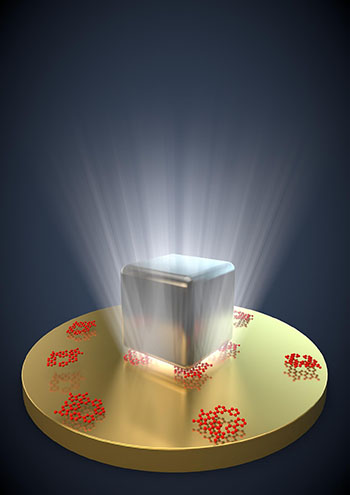
Artist's representation of light from fluorescent emitters, trapped between a silver nanocube and a thin sheet of gold. [Image: Gleb Akselrod, Duke University]
By sandwiching fluorescent molecules between a gold substrate and a layer of silver nanocubes, a team of scientists at Duke University, USA, has reportedly boosted the emission rate of the molecules by more than three orders of magnitude (Nat. Photonics, doi: 10.1038/nphoton.2014.228). The researchers see applications ranging from plasmonic lasers and single-photon sources for quantum cryptography, to “ultrafast” LEDs.
The work’s motivation, according to the team, arises from the increasing need for efficient nanophotonic light sources that can operate at room temperature, and across a broad bandwidth. Most practical luminescent emitters have relatively long emission lifetimes and pour out their light nondirectionally. These characteristics, the Duke researchers note, fit poorly with the needs of nanophotonic devices for most applications, which require the ability to rapidly pump out streams of highly directional photons.
The Duke team sought to resolve that mismatch by enhancing the Purcell effect—the increase in the spontaneous emission rate when the emitter resides in a resonant cavity. To create the right geometry for resonant enhancement, they fashioned a nanoscale plasmonic patch antenna, by sandwiching a polymer layer several nm in thickness, and impregnated with fluorescent ruthenium metal dye molecules, between a 100-nm-thick gold substrate and an overlying layer of silver nanocubes, each measuring around 80 nm on a side. Adjusting the thickness of the polymer layer allowed the team to tweak the size of the resonant cavity between the gold and the nanocube layer to achieve the maximum Purcell enhancement.
With the fluorescent source trapped in the “nanogap” between the gold layer and the silver nanocubes, the team observed an emission rate enhancement of greater than 1,000 times for a 5-nm-thick gap. Moreover, the nanocube geometry made the emission highly directional, with an estimated 84 percent of the radiation falling within the collection cone of a 0.9 NA objective lens. And the team believes that emission rate enhancements far higher than the measured three orders of magnitude are possible with more refined positioning of the emitter dipoles within the cavity.
These qualities, according to the scientists, could make the plamonic nanopatch geometry—which, the team stresses, can be extended to boost the emission rate of short-lifetime emitters such as quantum dots—an interesting potential platform for single-photon sources. The hope is that getting such light sources “up to speed” will reduce one barrier to moving nanophotonic applications, such as quantum cryptography, into practical use.
